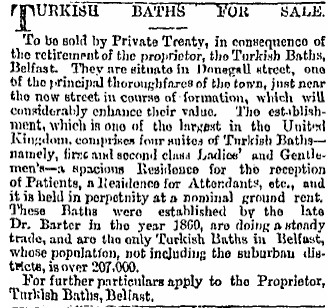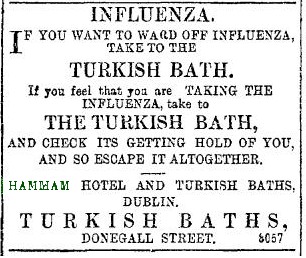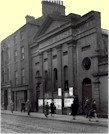The Working Class Turkish Baths in Belfast were set up by Dr Barter following two public meetings held on 22 March 1860 at the Music Hall. Both were well-attended by ‘the most respectable portion of the inhabitants of the town’. 6
It was originally intended that the baths were to be built by the newly formed Belfast Turkish Baths Company Ltd but, probably because there was insufficient financial support for an establishment designed for the working classes, the baths were built by Barter at his own expense and the company later dissolved. 7
The actual construction of the baths was not uneventful. On 10 August, at eight in the morning, the top of the front of the building parted from the newly slated roof and collapsed so that the brickwork fell onto the pavement taking the scaffolding and its surrounding hoarding with it. Fortunately no one was hurt and work was later resumed. 8
Although, by 1860, Belfast was recognized as 'a great and populous manufacturing and maritime city', 9 Barter’s were the only baths available apart from some privately owned slipper baths. It was to be another three years before his Turkish Baths for the Destitute Poor ('The People's Turkish Baths') opened in Cork.
The Donegall Street baths opened ‘for the use of the Working Classes’ on Monday 1 October, with bathers entering at the rear of the baths from number 43 Little Donegall Street, a smaller road running parallel to the main one.
Even in what were called the Second Class baths there were two admission prices. Between six and eight o’clock in the morning and evening, a bath cost 6d, while between ten in the morning and four in the afternoon, the charge was 50% higher at 9d. Shampooing ‘with the use of a sheet’ cost 3d. Children under ten years old were allowed in at half price and under the age of four years entrance was free. 1
 When the First Class baths opened (entrance through the front door) there was a similar two class structure based on the time of day, the cost of a bath being 1s.6d.
or 2s.6d. A shampoo cost 6d. and there were reduced prices for those paying for twelve tickets at a time.
10
When the First Class baths opened (entrance through the front door) there was a similar two class structure based on the time of day, the cost of a bath being 1s.6d.
or 2s.6d. A shampoo cost 6d. and there were reduced prices for those paying for twelve tickets at a time.
10
In spite of this, the baths appeared to be slow to catch on and articles appeared in the local press singing their praise, or wistfully preaching.
If working men would visit the second-class baths on Saturday evenings, instead of the public-house, which too many of them frequent, they would find their health benefited by it, and their strength invigorated for the labours of the ensuing week. 11
While the baths continued to be known as the Working Class Turkish Baths until at least 1872 (ie, two years after Dr Barter's death) they do not appear to have been very successful. Thomas Coakley, the manager, wrote to Richard Metcalfe in 1872 saying that,
…though…in operation here about twelve years, yet, so very few avail themselves of them, that, in fact, they are not worth keeping open, inasmuch as they are not paying expenses. 3
In an attempt to reduce these, an appeal was made to the Belfast Water Board for a reduction in their water rate. Through his representative, Mr Ruddell, Barter reported that in march 1871 he was paying £14 15s 3d per year, but now, because the premises had been enlarged, he was being asked £22 11 6d. To encourage the working-classes to use the baths more, Barter offered to reduce their entrance charge by a quarter if the Commissioners were prepared to supply his water at a fixed charge of £20. ‘Mr Ruddell thought that ‘if the Commissioners would agree to that proposal they would confer a boon upon the inhabitants of the town.
Although several Commissioners appeared to look favourably on the proposal, the Chairman ruled that a written application should be made and an agreement drawn up indicating what each side undertook to do, and the matter was dropped.
Dr Barter died on 3 October 1870 and the baths, as part of his estate, passed to his eldest son, Mr Richard Barter. Although Richard Barter's main interest was in agriculture and the farm at St Ann's, he still kept a close watch on the Turkish bath establishments and was not slow to make improvements when these became necessary.
Nevertheless, the baths were offered for sale in July 1881 although it is not known with what result. 12

What we do know is that the baths were bought in November 1892 by John North who, ten years earlier, had purchased Barter's large Dublin establishment in Upper Sackville Street. The newly acquired baths were immediately closed for refurbishment. After inspecting them, North initially decided to remove the inner walls so as to be able to construct a more up-to-date facility. But it seems that, in the event, ‘the old buildings were demolished, the site cleared and excavated, all sewage-tainted earth removed, and a new concrete bottom for the new floors laid down throughout.’ 13
Although there had been some facilities for women before, the new building had four sets of baths, first and second class for men and women. Each had shampooing rooms, a wide range of showers including needle, douche, spray, and pine, as well as sulphur and plunge baths. The alterations were stated to have cost £4,000, and the work was carried out by the same Dublin team of architect, builder, and plumber who had been responsible for refurbishing the Dublin baths.
When they re-opened on 26 June 1893 North renamed them 'Hammam Turkish Baths' to emphasize their link with his Dublin Hammam Hotel and its Turkish Baths. Whether they became much more profitable under his aegis is not known, but there must surely have been some improvement. He certainly gave the impression that there was enough demand for him to transfer 'from the "Hammam", Dublin, a fully-qualified Masseur who is skilled in Electric and all Medicated Baths'. 14
Both of North's establishments were frequently advertised together and, like the proprietors of other establishments (such as Miller & Jury's Dublin baths at Stephen's Green West), North saw contemporary influenza epidemics as opportunities to offer his Turkish baths as both preventative and cure. 15

But, also in common with many other proprietors, North found that in spite of spending considerable sums on providing facilities for women bathers, their baths were not well patronised enough to make a reasonable profit. North closed them in December 1895, just two and a half years after they opened. But a petition was raised, and there were just enough signatures to persuade him to reopen them for two days in the week. 16
By now, John North was approaching 60 years of age and had latterly been one of the two Vice-Presidents of the Hotel and Restaurant Proprietors Association of Ireland. After he died, the Donegall Street Turkish Baths, together with the Dublin hotel and baths, passed to his son-in-law, Joseph Armstrong. Joseph had already in 1901, at the age of 33, been managing the Hammam Hotel and was well experienced. He, and later his son Oliver, continued running the baths till early in 1936 before they finally closed. (The Hammam Hotel had a more violent end.)
 Profitable or not, much regret was expressed at the closing down of such a popular Belfast institution. It was suggested that the City Corporation should purchase and run the baths and a meeting of the Baths and Lodging House Committee met on 11 August 1936 to consider such a purchase. 17
Profitable or not, much regret was expressed at the closing down of such a popular Belfast institution. It was suggested that the City Corporation should purchase and run the baths and a meeting of the Baths and Lodging House Committee met on 11 August 1936 to consider such a purchase. 17
Courtesy
NMNI
&
Belfast Telegraph
However this did not materialize, the baths remained empty, and another ten years were to pass before the building was finally demolished in November 1946 to make way for a new garage.